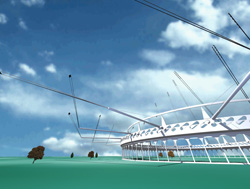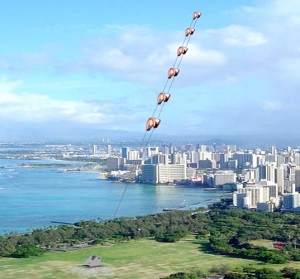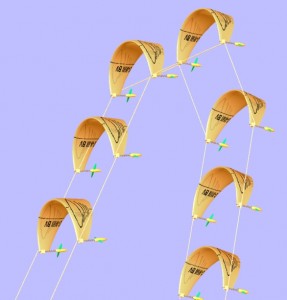Wind Power From Kites
The world over, experiments are under way to generate wind power from kites. Wind power from kites or other objects suspended in air are not new, but have been mostly ignored for decades. The first U.S. patent for such a device was filed in 1966, and similar patents in the States were filed throughout the 1970’s and 1980’s. But these precursors to wind power generators such as KiteGen were simple affairs that generated small amounts of power. Today, prompted by climate change and the need for cheap, clean electricity, they can generate upwards of 10 Megawatts per kite, with larger wind power kite farms projected to generate 100 Megawatts or more. In fact, current projects claim that a single farm, or array of wind power kites, could generate the same electrical output as a Nuclear power plant.
KiteGen – Italian Wind Power
KiteGen is the Italian entry into the field of wind power, using one or more kites in series, and anchored to a single base. As the kites are buffeted by high level winds, they spin, and this spin is captured by the base unit, where it is converted into electrical output. This method shows that generating 100MW from a single installation is both plausible and conservative. KiwiGen is a similar project, but differs in the capture mode. Where Kitegen uses a single base unit per kite which generates around 10 Kilowatts, KiWiGen employs a carousel approach, where a series of kites are flown from a ground-based, circular platform, targeting the Gigawatt range of wind power generation. Both types boast a small to non-existent carbon footprint, ease of placement and production both on land and in marine based applications, and operational costs that are less than half of conventional methods.

WPI Kite Power Team
In the United States, Worcester Polytechnic Institute has recently begun the WPI Kite Power Team, which has successfully built and demonstrated small scale wind power generation in a similar fashion. This project isn’t in the same league as the Italian endeavors, which are aiming for the production of gigawatts, but the early results are certain to mean larger experiments are yet to come. This model use the up and down motions of kites, and converts it at the base unit into rotational power which in turn drives a generator. The result is a small ground unit and a typical air foil, such as those used by wind surfers. The design uses a commercially available sport kite which is 10 meters squared in size.

Kite Generated Wind Power Makes Sense
By flying the kites at higher altitudes, wind power generation is increased, constant, and reliable. Where traditional wind turbines cannot feasibly be built to capture winds at high altitudes, these kites make efficient use of higher elevations, translating into increased power production at a reduced cost. Because of their small requirement of surface area, installations of this sort could easily be implemented in areas, including remote areas, offshore installations, and even rooftop mountings. The largest restriction on their usage comes from air traffic, as the extreme elevations would require a no-fly zone in the zone being used to generate wind power. It has been “worked out that flying kites in a figure of eight pattern means the air flowing over them travels even faster than the ambient wind speed. When a kite needs to be reeled in, it is angled so that it falls out of the sky like a glider, without the need for much power.”



The trouble isn’t generating and storing wind power. It’s transferring it from the wind power collection site to other cities. http://www.iht.com/articles/2008/08/26/business/grid.php
That’s an excellent point, Scott! We’ll try to address the issue in future articles, and look at some of the possible solutions that are being developed. For the most part, though, those solutions basically require that agencies and state boundaries become more cooperative. The technology isn’t the problem, after all, it’s the bureaucracy that needs to be overhauled.
Yeah, I think the problem would be moving the stored wind energy to the necessary places that needed it. I would imagine the energy would slowly dilute and ebb out from the storage if traveling far.
That's the power of kites! I am really very happy that, I am kind of associated with kites!
That's the power of kites! I am really very happy that I am kind of associated with kites!
This is huge, I just loved the whole idea behind it!
This is just amazing, thanks for sharing it, I am impressed, keep coming with interesting entries like this.
Dave
How can you store wind power.You cant Store energy.The main problem is transferring power to cities.
http://www.gedayc.com
wind generator 60% more powerfull